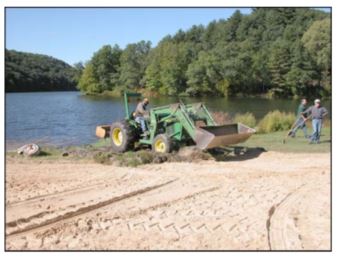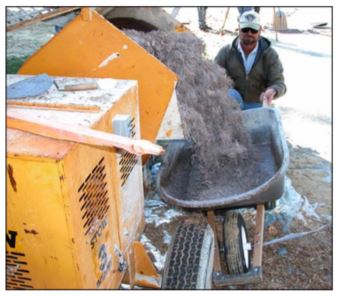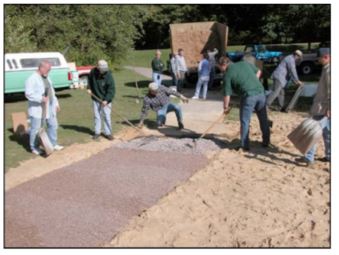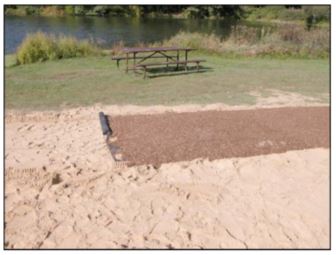Bonded Beach Path Installation
The two binder systems used to fabricate the beach path surface were
-
an acrylic and polyvinyl acetate polymer emulsion, SoilSement (Midwest Industrial, Canton, Ohio), mixed 30% by dry weight of solids to unit weight of dry EWF and applied 63 mm (2-1/2 in.) thick, and
-
a non-foaming polyurethane, Vitri-Turf (Vitricon, Polymer Plastics Corp., Commack, New York), mixed 30% by weight with unit dry weight of EWF and applied 37 mm (1-1/2 in.) thick.
Because the installation occurred in the fall, we monitored air temperature; both stabilizing binders required 4°C (40°F) for proper curing. On the date of installation, the overnight temperature was 7°C (44°F). The binders had been stored at room temperature. When the binders were mixed with EWF, the temperature of the mixture was well above 10°C (50°F). The EWF was shoveled directly from the truck into a 160-L (40 gal) portable mortar mixer. The amount of binder added was determined as a proportion (30%) of EWF dry weight (volumetrically equivalent to 0.041 m3 (1.45.ft3) of EWF to 5.3 L (1.25 gal) of Vitri-Turf or 10.6 L (2.5 gal) of SoilSement. Weight proportion was 77:23. The binder and EWF were mixed for approximately 2 min and transported to the target pad in polyethylene tray wheelbarrows (Fig. 3). The binder-EWF mixture was spread with hand tools to an even thickness (Figs. 4 and 5). The area was then compacted and flattened with a 1.2-m by 1.2-m by 16-mm (4-ft by 4-ft by 5/8-in.) piece of plywood covered with a polyethylene release sheet. A 90-kg (198-lb) person walked on the plywood in each quadrant to apply firm compaction pressure. At the termination of the path at the waterline a 0.1-m (3.5-in.) curb was formed to reduce any inadvertent rolling of the path into the water and to stiffen the edge directly in contact with wave action.
Figure 2-Grading of beach path to waterline.
Figure 3-Loading of binder-EWF mixture from mortar mixer into wheelbarrow.
Figure 4-Leveling and compaction of binder-EWF mixture near junction with asphalt path.
Figure 5-Termination of Soil-Sement portion of beach path. Geotextile fabric visible under completed SEWF surface.
The two SEWF surfaces were allowed to cure or bond for 5 days prior to use (Fig. 6). Because rain was not predicted, the entire surface was left exposed. Overnight temperatures stayed above 4°C (40°F) for 2 days after installation. Within 2 h of installing the Vitri-Turf, the surface was somewhat rigid to hand pressure. The Soil-Sement surface was slower to stiffen and was deemed stiff within 48 h. Five days after installation, the barriers were removed and the edge of the path was backfilled with beach sand using rakes. The completed beach path after 2 months of weathering is shown in Figure 7.





User Comments/Questions
Add Comment/Question